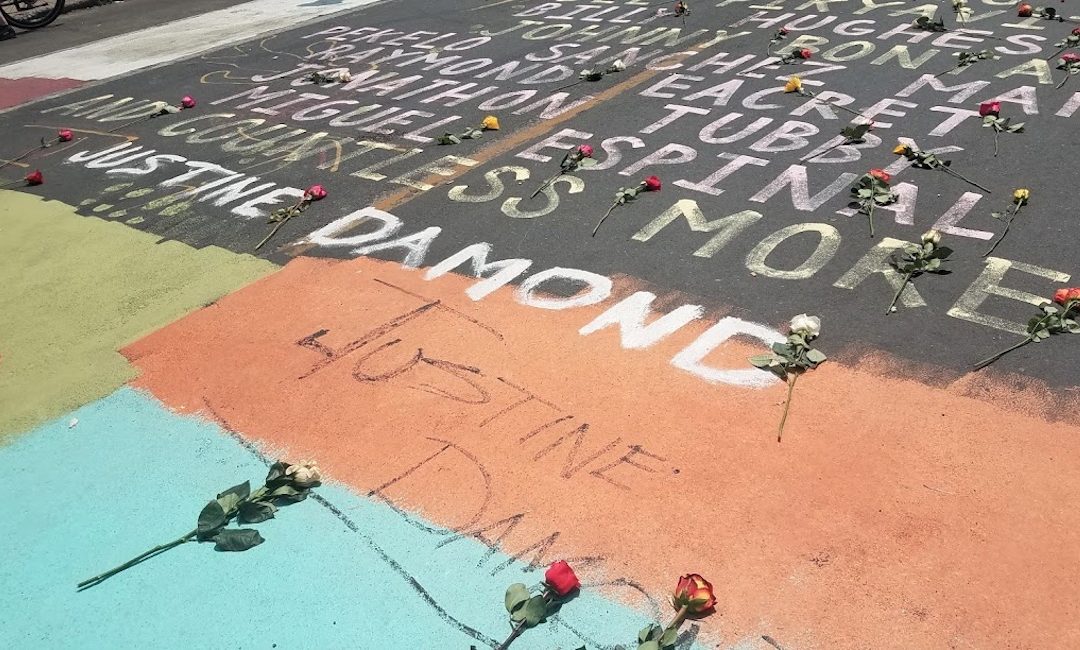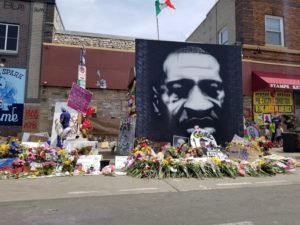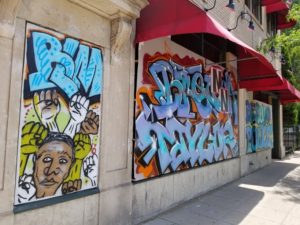A snapshot of life near the South Minneapolis protests
Author Note: I’m taking a break from the usual Writing Tips to share a few profiles and thoughts about the protest movement in my hometown. Below is only one perspective. I am connecting with friends in South Minneapolis and hope to profile more. Names are changed to protect privacy.
Photo above courtesy Sierra Taylor, 2020.
The barricade was cobbled together, but they hoped it would hold. On Saturday, May 30th, after a week of protests and growing concern that white supremacist groups were arriving to aggravate the situation, Leah Taylor’s husband and neighbors were out removing stones and other objects that might be used to break windows. A few neighbors worked together to drag hefty “Road Closed” signs from a nearby construction site and sand-bag them into place at either ends of their street. Around South Minneapolis, several neighborhoods took similar actions—supporting the protests, while mitigating the risks of possible rioting.
The barrier certainly wasn’t impermeable. That wasn’t what they intended. But it would be, as Leah put it, “really, really hard to move,” an effective deterrent against vehicles and a significant speed bump for a crowd.
They felt a little safer with the makeshift barricade in place. Ironically, for the mixed-race community, most of their time lately has been focused on removing barriers, on connecting with the most vulnerable and taking care of each other.
I spoke with Leah at length on June 1st, one week into the protests in response to the police murder of George Floyd. Leah lives in South Minneapolis, about four blocks north of Lake Street where the rioting has been the worst. She named the businesses burned or damaged, ranging from big corporate brands to basic infrastructure and tiny family-owned shops: Auto Zone, the Third Precinct, Walgreens, the post office, Gandhi Mahal Restaurant, Town Talk Diner, Uncle Hugo’s Bookstore, East Lake Library, MIGIZI youth center, Target, Aldi, an under-construction affordable housing building, and many others. Some were completely destroyed.
Leah described signs in windows of some spared businesses that have loft apartments above: “Do not burn, children sleeping upstairs!” She also heard that, at the Global Market, a multi-shop indoor market of mainly immigrant-owned businesses, local residents stood outside lining the building perimeter to protect it from being burned.
For now, Leah and her husband, Curtis, and their neighbors stay awake most of each night. They keep in touch with each other with a cell phone app. The neighborhood is not far from Little Earth, an Anishinaabe housing community, which is sovereign tribal land. “Our curfew doesn’t apply to them, and they’re allowed to patrol their block all night,” Leah said. “I feel a lot safer knowing they’re out there. They know their community and our neighborhood too.”
Leah and her neighbors have openly discussed what might qualify as “bad enough” that they need to leave the city. Some of the neighbors are elderly or have young children. They’ve pledged to leave together, those with cars helping out anyone who doesn’t, so they can keep track of each other. “Our bags are packed,” Leah said. But for now, she wants to stay put, to help.
By night, they’re on alert with their neighbors. Everyone takes turns getting a few hours of sleep in the early morning. By day, they’re all supporting the peaceful protest efforts and bringing groceries to people who can’t leave their homes or have no transportation.
“We have to drive six miles to get food right now,” Leah said. “The stores are all either burned down or closed.” The local pharmacy is burned down too, and people who try to get their prescriptions filled elsewhere are told they have to get a new prescription from their doctor. “They’re saying this to people who have no resources to begin with!” Leah said, exasperated. “And all the small local clinics are closed because of COVID. What are they supposed to do?” Her days are full helping neighbors trouble-shoot situations like that.
“Today was a quiet day,” Leah said, not sounding particularly relieved. “By that I mean, we’ve been hearing military helicopters overhead all day, but not much activity from the street. Sometimes we hear shooting in the distance. I don’t know if it’s rubber bullets or live rounds.”
When asked if she’s upset about the protests transitioning into rioting, Leah’s response was layered. She explained that her family and neighbors are worried the rioting could head their way, hence their latest precautions. But they’re also actively supporting or directly participating in the protests. They’re grieved about the recent damages to small, local businesses. But they’re enraged about the actions of the Minneapolis Police, and that’s been an issue for years.
“They don’t de-escalate… they intentionally escalate.”
Leah’s descriptions of her encounters with the Minneapolis Police are chilling. In recent days, “police have fired tear gas at people who are doing nothing, sitting on their porches after curfew,” she says. “Police have repeatedly used tear gas and fired rubber bullets at non-violent, unarmed, peaceful protestors.”
She believes the protests would have had a chance to remain peaceful “if the police hadn’t showed up in riot gear, looking like an army going to war.” Leah notes that the looting at Target started when police standing on the roof of the Third Precinct began sending tear gas, rubber bullets, and flash bangs into the crowd. Target is across the street from there. “So, that’s where the looting went first,” she says. “You know how sometimes you’re just so mad you want to throw something? Well, think about that times 400 years of oppression and silencing and then having someone shoot rubber bullets at you after a member of your community was killed.”
Leah also commented on the tanker truck that, purportedly, accidentally drove into a crowd of protestors on I-35W on May 31st. In a social media post, she stated, “…the second wave of police to arrive RAN… to assist the truck driver. The protestors had just been victims (of what appeared to be) a violent crime, and the officers did NOT jump out of the car saying ‘Are you okay?… Is anyone hurt?’ …No, they ran straight for the truck driver, where several witnesses have since confirmed that protestors were cooperating with the police, and they sprayed mace right into their faces.”
In our conversation, Leah sums up her opinion of police handling of the protests. “Our police force is not only not educated on de-escalation, they take action to escalate anything,” she says. Asked to expound, she’s more blunt: “Our police are mean. They’re bullies.”
Then she describes a number of concerning personal encounters with police, stating that things have gotten especially bad in the past ten years. Two incidents stand out significantly.
She and Curtis now live in the same house as his parents. They used to live at the other end of their block. When they moved, they rented out their old house. Several years after that move, their rental house was hit by a stray firework set off from the park across the street. The house caught fire and was almost completely destroyed by the blaze and water damage. Thankfully, the families living there got out safely. Only to be bullied by the police on scene.
“They treated our tenants like criminals,” Leah says. “Our tenants are Mexican and don’t speak English perfectly. They just lost everything, and then the police demanded to question each one alone and bullied them badly. They treated them like they were guilty of arson. We had already told them that it was a stray firework that hit the house. We had multiple witnesses in the park who saw it happen.”
On another occasion, one of Leah’s adult daughters was sitting in her parked car one day when a group of people nearby suddenly began to argue. Things turned physically violent and a few of the people began pounding on her car. Leah’s daughter screamed, laid on her horn to alert her neighbors, and immediately called the police. The fight broke up, and an officer arrived and took a report. The officer initially questioned the validity of her daughter’s report. He also told Leah and her daughter, “If you don’t want to experience crime like that, you shouldn’t live here.”
Leah is white, her daughter is a Person of Color, and Leah wonders if race influenced the officer’s attitude. She adds, “If that’s how the police feel about Minneapolis, they shouldn’t work here. This is our home!” She wasn’t entirely surprised when she learned that the officer who took down her daughter’s report was involved in the George Floyd arrest and lynching. He was one of the officers who stood by and did nothing.
The incidents that Leah shares are mild compared to numerous other well-documented police misconduct incidents involving the Third Precinct, particularly in the past decade. “There is nothing good about our police force,” Leah says. “Nothing. They need to get rid of everyone and start all over.”
As far as she can tell, the mainstream rhetoric about “a few bad eggs” doesn’t apply here. At this point, it would be more accurate to say there might be a few good eggs left. But there’s so much corruption from the top down that the “good” officers do nothing about witnessed oppression. That passivity, even if it’s out of fear of retribution and job loss, is as bad as the oppression itself. It’s the silence that maintains the violence.
Who can we trust now?
The neighborhood has destabilized. The police are corrupt. Government officials make statements, then retract them the next day. Social media feeds are full of inflammatory rumors, mock “insider reports” claiming to know how the riots will play out the next night. “We never know who we can believe,” Leah says. “We believe our closest friends when they are firsthand witnesses of something.”
It doesn’t help that some rumors begin to manifest as true. Leah had heard about the possibility that “outside influences” were involved in the shift from peaceful protesting to rioting. Then a friend told her that this was more than rumor. The first night, when the burning began, “Black protestors caught a white man wearing a gas mask and a bullet-proof vest trying to light a car parts store on fire,” Leah says. “They tried to catch him and he pushed them away. He was not part of the protests.” The man wound up successful in his efforts. He set Auto Zone on fire, and it burned to the ground.
Several reports in this vein have been confirmed now, involving white individuals wearing bulletproof vests and carrying incendiary equipment or assault rifles and occasionally driving in vehicles marked with white supremacist insignia. Is it possible the peaceful protests never would have turned into riots without white supremacists inciting that shift?
On one of Leah’s errands out to the suburbs to get groceries, she says she saw dozens of out-of-state license plates as well as cars with no plates and “many more dealer plates than usual.” She describes most of them as large SUVs, vehicles with a lot of cargo space. “This is not normal,” she says. “My guess is these (unmarked or oddly marked cars) are white supremacists. Some of them are KKK for sure. We do know that the KKK are here now.”
She yawns. She is clearly exhausted from sleep deprivation, long hours helping neighbors, and having to filter through all the urgent information she receives each day. Could this tip help us stay safe? Or is it bogus, just meant to fan fears?
Her tone strikes a chord in me. Her weariness is familiar. As a memoir ghostwriter, I’ve connected with several refugee survivors and combat veterans over the years. Exhausted. Jumpy. Distrustful. Numb. Leah is speaking the language of war survivors.
Holding Multiple Truths
Leah describes her emotional landscape as one in which she’s learning to hold multiple realities side by side by side. On one hand, she wonders if the protests would have stayed peaceful if not literally fanned into flame by white supremacists. She wonders if a police force trained in de-escalation would have changed the outcome. On the other hand, she also wonders if the current climate made the rioting inevitable and tragically necessary. Leah quotes people of color in her neighborhood, who have said to her repeatedly this past week: Things have to get really painful before we are heard.
Peaceful protest. Violent rioting. Justified anger. Painfully cautious hope. She wrestles with several simultaneous truths. She is worried for her family’s safety in this moment and simultaneously she realizes many friends have lived with existential dread every day, their whole lives.
With a similar mix of sadness and righteous anger, many of the immigrant small business owners whose shops have been destroyed are grieved over the damages and simultaneously support the protests. Yes, the businesses matter, inasmuch as they are community resources, and each small independent store represents an individual family’s livelihood too. But those small business owners have, on a whole, had a more philosophical response. Amy quotes the increasingly common sentiment: This is hard, but that’s how bad the situation is. We don’t need police reform. We need a complete overhaul. Business loss matters, but loss of life matters way more. What matters is the constantly growing list of people whose lives have been cut short by police brutality.
Sometimes it feels like things could get better. Though Leah clearly doesn’t want life to go back to normal. She hopes the latest tragedies finally spark the fire of real change: the necessary destruction and reinvention of corrupt systems. She hopes the protests are more than just a pressure relief valve. The worst outcome would be if people protest for a time, but then normalize out of sheer exhaustion and overwhelm at the enormity of the problem.
Leah comes back to a comment she made at the start of our conversation, when I asked her, foolishly, how she was doing. “I’m safe at the moment,” she says. “I’m safe. I’m not okay.”
Take Action
Protesting and marches are powerful. We must not stop there. If you’re a white ally, first let go of the concept of being “not racist”. Right now (and always) our nation needs much more than passive “not-badness”. Black, Indigenous, and other People of Color need the support of proactive anti-racism. This first list is specifically for you:
- Start here. Read How to be an Anti-Racist by Ibram X. Kendi
- Get connected with racial equity groups in your own region. Get on their mailing lists. Donate. (If you’re in Montana, get connected with and support the Montana Racial Equity Project.)
- Give of your time. Craft a skillset list and let your local equity groups know that you want to help. Be ready to help with tasks outside your skillset too!
Support Rebuilding Efforts in Minneapolis
Wherever YOU live, look for similar organizations in your city and region! Thank you to Leah Taylor for helping to craft this list.
Black Visions Minnesota – An organization “committed to a long-term vision in which ALL Black lives not only matter, but are able to thrive.”
Voices for Racial Justice – A movement organization “committed to building power through collective cultural & healing strategies for racial justice across Minnesota using organizing, leadership training, community policy & research.”
MIGIZI Native Youth Center – Help them rebuild! MIGIZI is “a circle of support that nurtures the development of Native American youth in order to unleash their creativity and dreams – to benefit themselves, their families and community.”
Little Earth Residents Association – Distributing food and other essentials to the community. (A note from Little Earth: If you would like to make a monetary donation to Little Earth Residents Association, please use our Give MN account at https://www.givemn.org/organization/Littleearth or our pay pal http://paypal.me/LittleEarthResidents )
Holy Trinity Lutheran Church – Near the Third Precinct. Collecting and distributing necessities for those displaced by the fires and people who now lack access to basic supplies and food.
The Open Door – Regional food pantry network.
We Love Lake Street – Helping all rebuilding businesses.
Twin Cities Eater – Compiled a list of fundraisers to help locally owned restaurants rebuild: https://twincities.eater.com/2020/6/1/21276830/donate-restaurants-burned-destroyed-fire-riots-minneapolis-st-paul
More Reading
- Say Their Names – This podcast transcript by NPR Code Switch includes a (not-comprehensive) list of recent victims of police brutality. The podcast is also worth a listen (or read). Google individual names. Learn about the people and their families. Many have foundations and GoFundMe pages.
- Minneapolis Star Tribune – Reported on a decade-long history of misconduct in MPD’s Third Precinct.




Wonderful, layered article. Really gave me a feel for how people in the “war zone” are coping.
I am just reading this timely article now…a few weeks after publication. Thank you for taking the time to interview a person living at the scene of all this, and then writing about it. This is very helpful. Also, I appreciate the links to other articles. Great to put in links on how to help. Great work, Anika.